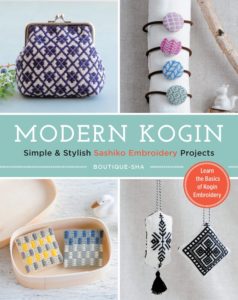
Boutique-Sha, 220, ISBN: 978-1-9405-5245-3, $19.99
This is an absolutely wonderful book with plenty of delightful kogin projects. Kogin is a form of pattern darning that is a traditional art in Japan. Originating in the 17th Cenury in northern Japan, traditional kogin is always blue and white. Often densely stitched with thick cotton threads, kogin created extra warmth when Japan had strict laws about dress.
Today kogin is experiencing a revival with modern projects, like the ones in the book, using many colors, less dense stitching, different threads, and both decorative and practical items. As you can see from the cover, kogin can be used in many ways and on many grounds. In fact the two brooches in the lower left look like they are are both stitched on needlepoint canvas.
Although properly Kogin is stitched on a fabric ground, many kogin patterns and projects can easily be stitched on needlepoint canvas (many of the patterns in the 25 Darning Patterns are based on kogin patterns, find the classes here).
Being a translation of a Japanese book, readers may find the organization a bit odd. Take comfort, everything you expect is there, just in a different order.
The opening section of the book has color pictures of the 24 projects with a short description, there are no instructions in this section. Some of the projects, such as the hair ties pictured on the cover have multiple designs. Others show various options for placement of the same motif.
Following this is an excellent section on basics and on how to stitch kogin. With lots of pictures, it’s the best instruction on kogin in English I have seen. Especially nice for North American readers are the instructions for embroidery floss. You can find kogin thread that’s imported from Japan (I buy it on Etsy), however using floss will give you a similar look. The section concludes with a smaple project.
After the basic instructions, are the instructions for each project. These include clear charts of each pattern and lists of materials. Best of all are the detailed illustrations for making the projects, including full-size templates if needed. Since many of the items are less commonly made outside Japan, this is fantastic. Because most of the projects use 18-count evenweave fabric this is excellent for needlepointers because those templates can be used directly for needlepoint.
The book concludes with a page of online resources.
About Janet M Perry
Janet Perry is the Internet's leading authority on needlepoint. She designs, teaches and writes, getting raves from her fans for her innovative techniques, extensive knowledge and generous teaching style. A leading writer of stitch guides, she blogs here and lives on an island in the northeast corner of the SF Bay with her family

Leave a Reply